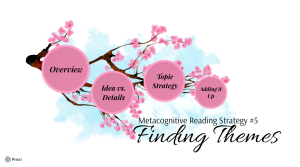21 Finding Themes
Learning Objectives
-
Practice strategies for finding themes and identifying main ideas in narratives and informational texts.
-
Use metacognitive reading strategies before, during and after reading fiction, non-fiction and graphics.
Chapter & Discussion
This chapter includes a presentation that can be navigated in a classroom setting or independently. You can access the presentation via the link below.
Work through the different sections of the chapter and discuss ideas and topics as they arise. If you’re working independently, take notes instead. Notes and active discussion will be helpful in navigating this week’s assignments.
Overview
Our next strategy is to look for main ideas or themes as you read.
We write because we have something to say. Every thing you read is trying to communicate big ideas to you. Remember this mantra when you are looking for the main idea or theme.
Today, we’ll go over three strategies to help you sift out relevant and useful information, and hopefully identify main ideas and themes:
- Knowing the difference between main ideas and supporting details
- Using the topic strategy
- Using logic to add up the conclusion to the premises that the author introduces

Idea vs Detail
Every sentence you read in a paragraph is either going to:
- Be the main idea of that paragraph
- Support the main idea of that paragraph
When you read, try to determine what each sentence is trying to accomplish. For example:
- Topic sentence in an article (main idea)
- An argument for why an idea is true (support)
- A character reflecting on what they learned (main idea)
- Evidence to back up an idea (support)
Practice: Main Idea vs Supporting Details
In this paragraph, identify each sentence as a main idea or a supporting detail.
Humane Society of Southern Arizona CEO Steve Farley and Chief Programs Officer Christian Gonzalez were suspended by the group’s board of directors following the launch of an investigation into an incident involving the whereabouts of 254 small pets. The board said in a press release Saturday that it “understands 254 of the animals at issue were placed in adoptive homes,” and “is aware of no evidence to the contrary.” In the almost two months since more than 300 rabbits, guinea pigs, hamsters, and rats were transferred from the San Diego Humane Society to the Humane Society of Southern Arizona, the board has refused to offer any evidence on the whereabouts or wellbeing of the animals, and continued to refused to answer questions on Monday about what evidence they had to assert that they had an understanding that the animals were placed in adoptive homes.
-Danyelle Khmara, AZPM, September 2023
Topic Strategy
This strategy is especially useful in literature. When you read, try to determine the topic that the author is exploring. You can find this by:
- Looking for repeated ideas, images, or motifs
- Looking for background information
Once you identify the topic, ask yourself, “What does the author have to say about this topic?” You can find clues in:
- Supporting arguments and evidence
- Metaphors, motifs, and figurative language
- Looking for relationships between supporting details
Adding It Up
The final strategy for finding themes is to start practicing how to add up the information given to you. If you can identify premises in the writing (facts that the author establishes), you can use them to figure out their conclusions.
When reading for information, look for topic sentences, bold words and titles, and how they use arguments and evidence to prove their ideas.
In literature, look for repeated ideas and uses of metaphor, literary devices, and clues in the setting, characters, and plot.

Assigned Reading
Here are this week’s readings. Additionally, please read for your own personal enjoyment for 1/2 hour each day. This will be called your “Reading Zone” reading and it will coincide with many upcoming activities.
Understanding Theme via Reading Khan Academy
Problem Set: Practice Your Skills!
Click here to complete a ten-question problem set on concepts in this chapter.
Completing problem sets like this can be an important element of independent study towards completing your HSE. I write these to resemble the style of questions you’ll find on the Reading and Language Arts GED.
Assignment: Comparing Two Songs (300 Words)
The object of this assignment is to analyze and compare two songs with similar goals and to decide which one did a better job of meeting those goals.
To do this, you will need to discuss elements of each song, such as writing, production, sound, and performance. You will need to make a case, with evidence, that shows why you think one of these songs did a better job of meeting its goals than the other.
To start, pick two songs that have similar goals. Some examples:
- Songs from the same genre
- Songs about the same subject (such as love songs, break-up songs, or songs about rebellion)
- Songs that try to make people dance
- Songs for a chill, rainy afternoon
- Songs that are inspirational
You can compare any two songs based on any shared goal. Once you’ve picked your songs, write 2-3 paragraphs in the following format:
- An introduction that helps the audience understand your songs, their shared goal, and which one did it better
- One or two body paragraphs that provide analysis of the artist’s choices and comparison
- A conclusion that sums up your case
Assignment: Reading Zone Response (250 Words)
For Reading Zone, you must find a novel that is interesting to you and enjoyable to read. If you need help finding a Reading Zone book, please ask. Please read your Reading Zone book for a half-hour each day. On class days, there will be time in class dedicated to reading.
Create a two-paragraph response to the reading you did this week. The first paragraph should summarize what you read this week. The second paragraph should address the following prompt:
What are some topics that appeared in your reading this week? What does the author have to say about those topics? What are some topics that have appeared throughout the book? What does the author have to say about those topics?
Attributions
Duke, N. K., & Pearson, P. D. (2002). Effective practices for developing reading comprehension. In A. E. Farstrup & S. J. Samuels (Eds.), What research has to say about reading instruction (3rd ed) (pp. 205-242). Newark, DE: International Reading Association. Reprinted in Journal of Education, 189, 107-122.
Khmara, Danyelle, (2023). Update: Humane Society Board suspends leaders Farley and Gonzalez, launched investigation into transfer of 250 pocket pets. AZPM News. September 30, 2023.
Mills, Kathy A. (2008) The Seven Habits of Highly Effective Readers. In Proceedings Stories, Places, Spaces: Literacy and Identity, National conference by the Australian Literacy Educators’ Association (ALEA) and Australian Association for the Teaching of English, Adelaide, SA.


